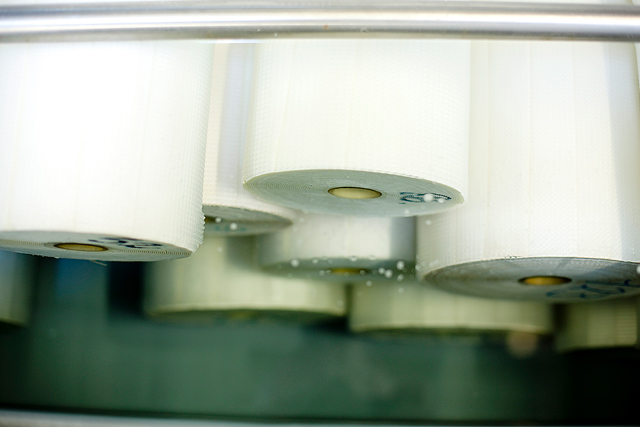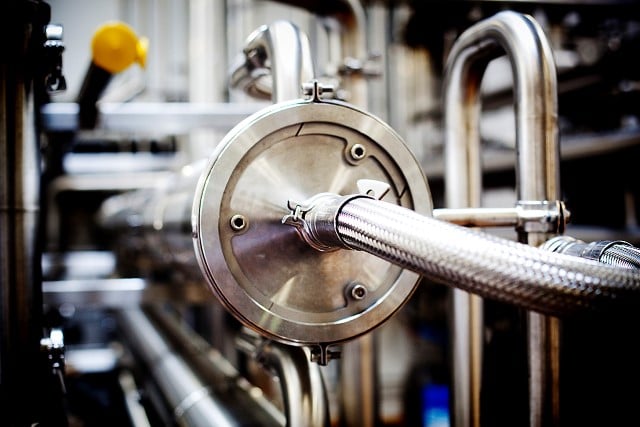Membranes - a profitable solution for Arla Denmark
At its plant set amongst the rolling fields outside the small Danish town of Videbæk, dairy producer Arla is turning what was once regarded as waste into a highly refined food ingredient. It is just one of the environmental benefits Arla gets from using Alfa Laval membrane technology.
DATE 2023-11-28 AUTHOR David Wiles
Each year Scandinavian dairy giant Arla produces many billions of litres of whey as a by-product of its cheese-making process. A few decades ago this greenish liquid – which is 95 percent water and the remainder lactose and protein – was viewed as waste and would have been returned to the farmers to be used as cheap animal feed.
Functional foods instead of waste
Thanks to membrane technology, this previously low-value waste product is instead refined by an Arla subsidiary, Arla Food Ingredients, into functional food additives that are proving to be highly profitable. Used by Arla in other applications, the membranes also have a number of environmental benefits, such as allowing dairies to reuse water in their processes and concentrating the whey before transport thus reducing the number of trucks on the road.
Expanding business
At Arla’s Videbæk plant in Denmark, construction workers are busy on an extension to the site that will allow the company to expand by about a third its production of food ingredients made by filtering whey.
“The frustration is that we need more whey than our own dairies can supply,” says Kristian Albertsen, director of R&D at Arla Food Ingredients, as he dodges between construction vehicles on the way to the company’s research facility. “So we have set up joint ventures in Europe and in South America so we can get our hands on enough of the raw material.”
Getting more value from whey
Inside the facility new ingredients are being produced in pilot plants. Albertsen explains that over the past decades whey has gone from being waste to feed to food. “Now we are going to the next stage,” he says, as he stands surrounded by kilometres of stainless steel pipes and the rich, slightly sweet smell of the whey that is gurgling through them. “By using ever more specialized membranes we are getting more value from the whey.”

The products Arla Food Ingredientsmakes from the residue of the filtering process today nourish newborn babies, the sick and the elderly. They also improve the consistency of ice cream and the moisture of cakes and give sports drinks the desired protein levels and a transparent appearance.
Higher protein amount with Alfa Laval's membranes
The ingredients come in the form of a white powder called whey protein. If you take 100 kilograms of whey, 95 kilograms is water and five kilograms is dry matter. “Of that five kilograms, 85 percent is milk sugar and 12 percent is protein; the rest is small amounts of fat and minerals,” explains Albertsen. “We want to increase the protein content from that 12 percent to 90 percent, and in order to do that we use membrane filtration. That is where Alfa Laval and their colleagues come in.”
Alfa Laval is one of the world’s leading suppliers of industrial separation technologies. The company supplies a wide range of industries with separation equipment based on centrifugal and mechanical principles. But there are many processes in which the substances involved, such as whey, are too delicate to withstand this treatment, and that is where membrane filtration is used.
Improved quality with high filtration
Comparing the basic principle with the way a coffee filter works, Albertsen explains that the whey is passed over the membrane, which is coiled like a roll of wallpaper about a metre long and placed inside a stainless steel tube. The surface of the membrane is covered with microscopic pores measured in angstroms (1x10-10 m). If you take an ultra-filtration membrane the size of this magazine page and blow it up to the size of Europe, then one pore would be the size of a football.
Membrane filtration separates out different components of the whey on the basis of the molecular size and shape of the micro-particles it contains. The better the filtration, the better the quality and value of the end product. “We can remove the components we don’t want, such as sugar, some of the minerals and some of the fats, and then we get a protein content of up to 90 percent,” says Albertsen.
Many parameters have to be fulfilled
 Some ingredients may pass through as many as 20 membrane plants and are then heat-treated or homogenized and dried into powders before they are ready to be used for their nutritional or functional properties. “We rely on good membrane technologies, and that is why we have teamed up with Alfa Laval,” he says. “There are a lot of parameters, such as performance, price and cost of cleaning, but on total evaluation Alfa Laval membranes are among the best.”
Some ingredients may pass through as many as 20 membrane plants and are then heat-treated or homogenized and dried into powders before they are ready to be used for their nutritional or functional properties. “We rely on good membrane technologies, and that is why we have teamed up with Alfa Laval,” he says. “There are a lot of parameters, such as performance, price and cost of cleaning, but on total evaluation Alfa Laval membranes are among the best.”
Alfa Laval has been supplying Arla Food Ingredients with membranes since the 1980s.
Environmental benefits
“We got into a close dialogue with a membrane producer that can translate our needs and make a membrane specially designed for particular applications,” says Albertsen.
Besides turning what was once waste into a highly refined product, Alfa Laval’s membranes also provide Arla with environmental benefits that contribute to the group’s sustainability goals, such as reducing water and energy consumption by 3 percent. At Arla plants, membranes are used to clean water used in assorted processes, reducing both the need for freshwater and the amount of waste generated. The matter left over after filtration can then be passed on to an energy company to be used as a feedstock for renewable biogas.
Far less transports
In addition, all of Arla’s cheese factories use standard membranes for concentrating the whey prior to transport to Videbæk. “They concentrate the whey up 45 times before transporting it here,” says Albertsen. “So instead of sending 45 trucks with whey from Sweden or Germany or elsewhere in Denmark, you only need one. And that of course has big environmental and cost benefits.”
While many dairies are struggling to stay profitable, Arla and others like it, with their own ingredients business, are faring considerably better.
“Over the past couple of years [the ingredients business] has been an increasingly good business to be in, due to a continually increasing demand for dairy products and especially the dried products that can be transported over big distances,” says Albertsen. “In future there will be greater demand for more specialized membranes to separate more proteins, fats or sugar types to meet market demands.”
Customer's voice
By using ever more specialized membranes we are getting more value from the whey.
Kristian Albertsen,
Arla Food Ingredients
